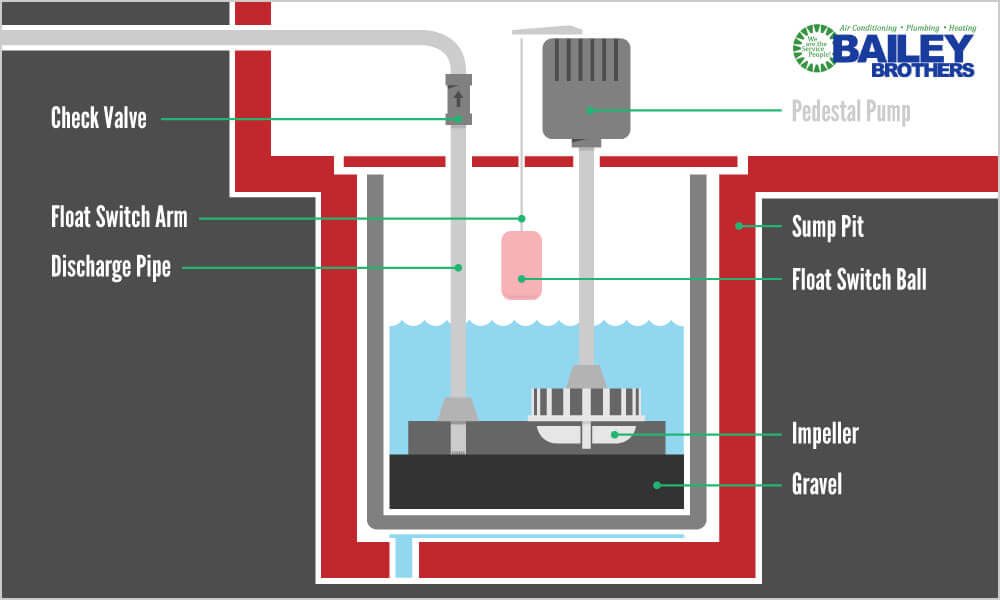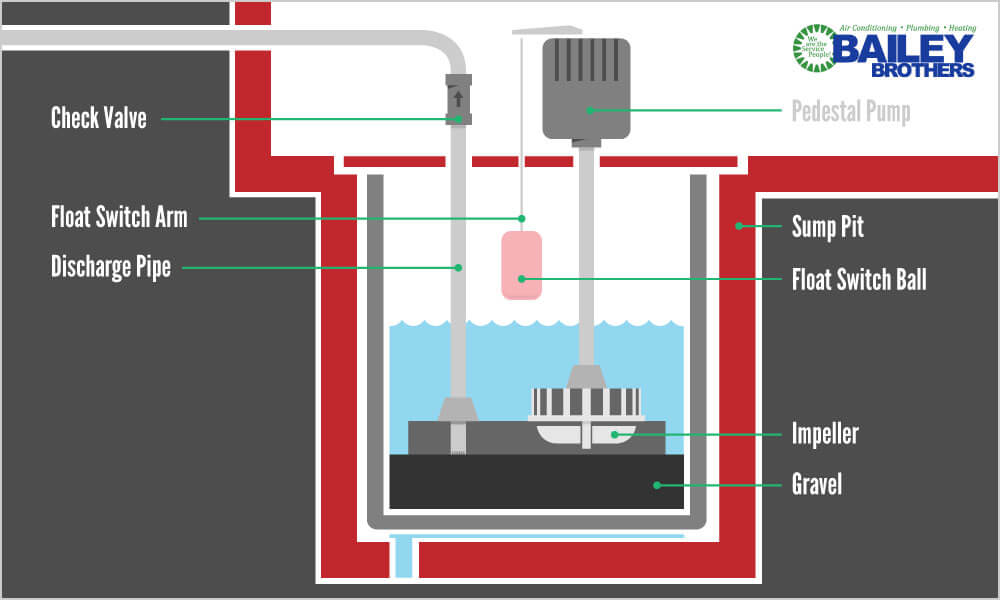Sewage ejector pumps handle waste from lower-level bathrooms or laundry rooms. These pumps can face issues over time.
Understanding common problems and their solutions can save you trouble. Sewage ejector pump troubleshooting involves identifying and fixing issues to ensure smooth operation. Problems can include clogs, power failures, or motor issues. Knowing how to handle these can prevent bigger messes and costly repairs.
This guide will help you navigate through common sewage ejector pump problems. You’ll learn to identify symptoms, understand causes, and apply simple fixes. With this knowledge, you can keep your sewage system running smoothly and avoid unexpected breakdowns.

Credit: baileyokc.com
Introduction To Sewage Ejector Pumps
Sewage ejector pumps play a crucial role in managing wastewater in homes and businesses. These pumps handle the challenging job of moving sewage from lower to higher elevations. This is particularly important in buildings with basements or below-ground facilities. Understanding how these pumps work is essential for proper maintenance and troubleshooting.
Purpose And Function
Sewage ejector pumps are designed to move wastewater from lower levels to main sewage lines. They operate by collecting waste in a pit. Once the waste reaches a certain level, the pump activates and transports the waste to higher ground. This prevents backflow and keeps your plumbing system efficient and clean.
These pumps usually have a float switch. This switch detects the level of waste in the pit. When the waste reaches a set level, the switch turns the pump on. After the waste is pumped out, the switch turns the pump off. This automated process ensures smooth and efficient operation.
Common Applications
Sewage ejector pumps are common in homes with basements. In these homes, bathrooms or laundry rooms are often below the main sewer line. Without a pump, waste would not move properly. These pumps are also used in commercial buildings with underground facilities. Restaurants, hotels, and hospitals rely on these pumps for efficient waste management.
Another common use is in properties with septic systems. These systems often require the waste to be moved from a holding tank to the main septic tank. The pump handles this transfer, ensuring the system runs smoothly. Finally, remote buildings like cabins or guesthouses also benefit from these pumps. They help manage waste efficiently, even in isolated locations.

Credit: baileyokc.com
Signs Of Sewage Ejector Pump Issues
Maintaining a sewage ejector pump is essential for a clean and safe home. Identifying early signs of issues can prevent major problems. Here are some common signs of sewage ejector pump issues you should be aware of.
Strange Noises
If your sewage ejector pump starts making strange noises, it may indicate a problem. Listen for grinding, rattling, or banging sounds. These noises can mean a part is loose or damaged. Addressing this early can prevent further damage.
Frequent Clogging
Frequent clogging is a clear sign of a sewage ejector pump issue. If you notice your toilets or drains backing up often, it could be due to a malfunctioning pump. This problem could stem from debris buildup or a worn-out pump.
Foul Odors
Foul odors around your home can also indicate a problem with your sewage ejector pump. If you smell sewage, it means the pump might not be working correctly. This could lead to health risks and should be addressed immediately.
Initial Troubleshooting Steps
If your sewage ejector pump is malfunctioning, following initial troubleshooting steps can help identify the problem. Fixing minor issues early can prevent bigger problems later. Here are key steps to start your troubleshooting process.
Safety Precautions
Safety should be your first priority. Before beginning any troubleshooting, ensure the power to the sewage ejector pump is turned off. This prevents electric shocks and accidents.
- Turn off the power at the circuit breaker.
- Wear rubber gloves and safety goggles.
- Ensure proper ventilation in the working area.
Following these safety precautions can help avoid injuries and ensure a safe environment.
Visual Inspection
Begin your troubleshooting with a visual inspection. This step can often reveal obvious issues.
- Check the pump and basin for any visible debris or blockages.
- Inspect the float switch to ensure it’s not stuck or damaged.
- Examine the discharge pipe for leaks or clogs.
If you see any debris, remove it carefully. A stuck float switch often causes the pump not to activate. Ensure it moves freely.
Leaking discharge pipes can indicate a problem with fittings or seals. Tighten any loose connections and replace damaged parts.
Following these initial troubleshooting steps can help identify and solve common issues with your sewage ejector pump, ensuring it functions correctly.
Common Sewage Ejector Pump Problems
Sewage ejector pumps are essential in homes with below-grade bathrooms. They move wastewater to the main sewer line. Despite their importance, these pumps face several common problems. Let’s explore some of the most frequent issues.
Pump Not Turning On
A sewage ejector pump that does not turn on can be frustrating. Check the power supply. Ensure the pump is plugged in and the circuit breaker is not tripped.
Next, inspect the float switch. If the float switch is stuck or damaged, the pump won’t activate. Clean or replace the float switch if necessary.
Pump Running Continuously
A pump that runs non-stop can lead to high utility bills. This issue often arises from a malfunctioning float switch or a damaged check valve.
The float switch might be stuck in the “on” position. Adjust or replace the switch. A faulty check valve can cause water to flow back into the pit, making the pump run continuously. Inspect and replace the check valve if needed.
Leaking Or Flooding
Leaking or flooding around the pump is a serious issue. It can cause damage to your property. Check for any cracks or damage in the pump casing. A broken pump casing needs immediate replacement.
Inspect the discharge pipe and fittings. Tighten any loose connections. Replace any damaged pipes or fittings to stop leaks.
Diy Solutions For Minor Issues
Dealing with a sewage ejector pump can be daunting. But some minor issues can be fixed without calling a plumber. These DIY solutions can save you time and money. Here’s how you can troubleshoot common problems with your sewage ejector pump.
Unclogging The Pump
A common issue is a clogged pump. To fix this, follow these steps:
- Turn off the power to the pump.
- Remove the pump from the pit.
- Check the inlet and impeller for debris.
- Use a plumber’s snake or a similar tool to clear any blockages.
- Reassemble the pump and turn the power back on.
Cleaning The Vent Pipe
The vent pipe allows air to escape from the sewage system. If it gets blocked, the pump won’t work properly. Here’s how to clean it:
- Locate the vent pipe; it’s usually near the pump.
- Use a garden hose to flush out any debris.
- Check for any visible blockages and remove them manually.
Resetting The Pump
Sometimes, a simple reset can fix pump issues. Follow these steps:
- Turn off the power to the pump.
- Wait for a few minutes to let it cool down.
- Turn the power back on.
- Check if the pump is working properly.
These DIY solutions are easy and quick. They can help you maintain your sewage ejector pump without much hassle.
When To Call A Professional
Dealing with a malfunctioning sewage ejector pump can be challenging. Sometimes, it is best to call a professional. Knowing when to seek expert help can save time and prevent further damage. Let’s explore some key indicators for calling a professional.
Identifying Severe Problems
Severe problems need immediate attention. Foul odors from your pump system may signal a serious issue. Unusual sounds like grinding or rattling require expert evaluation. If your pump cycles on and off rapidly, it could be a sign of trouble. A flooded basement or sewage backup demands quick action. Identifying these severe problems early can prevent major damage.
Choosing A Qualified Technician
Choosing the right technician is crucial. Look for licensed and insured professionals. Check their experience with sewage ejector pumps. Read reviews and ask for referrals. A qualified technician will diagnose and fix problems efficiently. Ensure they offer a warranty on their work. This guarantees peace of mind and long-term solutions.
Preventive Maintenance Tips
Regular maintenance keeps your sewage ejector pump efficient. It prevents unexpected failures. These tips will help you maintain your pump effectively.
Regular Inspections
Inspect your sewage ejector pump monthly. Check for any signs of wear or damage.
Here is a simple checklist:
- Check the power supply: Ensure the pump is plugged in and receiving power.
- Inspect the float switch: Ensure it moves freely and is not stuck.
- Examine the discharge pipe: Look for any leaks or obstructions.
Regular inspections catch problems early. This prevents costly repairs.
Proper Usage Guidelines
Proper usage extends the lifespan of your sewage ejector pump. Follow these guidelines:
- Avoid flushing non-biodegradable items: Do not flush wipes, diapers, or sanitary products.
- Limit grease disposal: Do not pour grease down the drain. It can clog the pump.
- Use water efficiently: Reduce water usage to avoid overloading the pump.
Proper usage reduces strain on the pump. This ensures long-term efficiency.

Credit: lenoxplumbing.com
Upgrading Your Sewage Ejector Pump
Upgrading your sewage ejector pump can prevent future issues and improve efficiency. A new pump can handle waste more effectively and reduce the risk of clogs. Knowing how to choose the right model and properly install it is crucial. This section will guide you through these steps.
Choosing The Right Model
Consider the capacity of your household. A larger home might need a more powerful pump. Check the pump’s horsepower. More horsepower means better performance. Look at the pump’s material. Cast iron is durable and long-lasting. Think about the float switch type. A vertical float switch works well in tight spaces. Also, consider the pump’s warranty. A good warranty can save you money in repairs.
Installation Tips
First, turn off the power to the pump. Safety is important. Then, remove the old pump carefully. Avoid damaging any pipes. Next, place the new pump in the same spot. Ensure it is level and stable. Connect the pipes securely. Loose connections can cause leaks. Finally, test the new pump. Make sure it works properly before covering the pit.
Frequently Asked Questions
What Are Common Sewage Ejector Pump Problems?
Common problems include clogging, power failure, float switch issues, and motor failure.
Why Is My Sewage Ejector Pump Not Turning On?
Check for power supply issues, tripped circuit breakers, or a faulty float switch.
How Do I Unclog A Sewage Ejector Pump?
Turn off the power. Use a plumbing snake to remove debris from the pump.
How Often Should A Sewage Ejector Pump Be Serviced?
Service your pump every 6-12 months to ensure it runs smoothly and efficiently.
Can I Install A Sewage Ejector Pump Myself?
It’s best to hire a professional to ensure proper installation and avoid potential issues.
Conclusion
Troubleshooting a sewage ejector pump can seem daunting. Follow these simple steps. Check power connections first. Inspect the float switch for proper operation. Clear any clogs in the discharge line. Regular maintenance prevents future issues. When in doubt, consult a professional.
Reliable sewage systems keep your home safe and clean. Stay proactive, and your pump will last longer. Happy plumbing!
